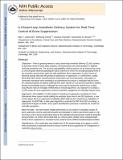A closed-loop anesthetic delivery system for real-time control of burst suppression
Author(s)
Chemali, Jessica; Liberman, Max Y.; Ching, Shinung; Brown, Emery Neal
DownloadBrown A closed-loop.pdf (1.376Mb)
OPEN_ACCESS_POLICY
Open Access Policy
Creative Commons Attribution-Noncommercial-Share Alike
Terms of use
Metadata
Show full item recordAbstract
Objective. There is growing interest in using closed-loop anesthetic delivery (CLAD) systems to automate control of brain states (sedation, unconsciousness and antinociception) in patients receiving anesthesia care. The accuracy and reliability of these systems can be improved by using as control signals electroencephalogram (EEG) markers for which the neurophysiological links to the anesthetic-induced brain states are well established. Burst suppression, in which bursts of electrical activity alternate with periods of quiescence or suppression, is a well-known, readily discernible EEG marker of profound brain inactivation and unconsciousness. This pattern is commonly maintained when anesthetics are administered to produce a medically-induced coma for cerebral protection in patients suffering from brain injuries or to arrest brain activity in patients having uncontrollable seizures. Although the coma may be required for several hours or days, drug infusion rates are managed inefficiently by manual adjustment. Our objective is to design a CLAD system for burst suppression control to automate management of medically-induced coma. Approach. We establish a CLAD system to control burst suppression consisting of: a two-dimensional linear system model relating the anesthetic brain level to the EEG dynamics; a new control signal, the burst suppression probability (BSP) defining the instantaneous probability of suppression; the BSP filter, a state-space algorithm to estimate the BSP from EEG recordings; a proportional–integral controller; and a system identification procedure to estimate the model and controller parameters. Main results. We demonstrate reliable performance of our system in simulation studies of burst suppression control using both propofol and etomidate in rodent experiments based on Vijn and Sneyd, and in human experiments based on the Schnider pharmacokinetic model for propofol. Using propofol, we further demonstrate that our control system reliably tracks changing target levels of burst suppression in simulated human subjects across different epidemiological profiles. Significance. Our results give new insights into CLAD system design and suggest a control-theory framework to automate second-to-second control of burst suppression for management of medically-induced coma.
Date issued
2013-06Department
Massachusetts Institute of Technology. Institute for Medical Engineering & Science; Massachusetts Institute of Technology. Department of Brain and Cognitive SciencesJournal
Journal of Neural Engineering
Publisher
IOP Publishing
Citation
Liberman, Max Y, ShiNung Ching, Jessica Chemali, and Emery N Brown. “A Closed-Loop Anesthetic Delivery System for Real-Time Control of Burst Suppression.” Journal of Neural Engineering 10, no. 4 (June 7, 2013): 046004.
Version: Author's final manuscript
ISSN
1741-2560
1741-2552